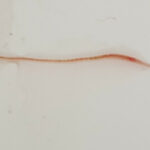
A reader wrote to us about some larvae in his indoor pool. He didn’t provide a ton of information about the creatures, only that they are red and small. However, he did tell us a lot about the pool: He explained that the indoor pool has a heater attached, and that there are many small cracks in the tiles and overflow channels. There is an AC duct that runs over the pool, but it hasn’t been opened or cleaned for a year. Finally, the pool has a pH of 7.4, which is the optimal level, 2.o ppm free chlorine, and TDS (total dissolved solids) of water of 1000. He claims the water is visibly clean. So, what are these red specimens? Why are they in his pool? And finally, what should he do about it?
We think they are midge fly larvae, or bloodworms! Although we don’t have a ton of clues to go off of, bloodworms are small and red, and they also commonly inhabit bodies of water. So, we think this is a match! Bloodworms can tolerate low oxygen levels, and they thrive in polluted waters. He says the water is visibly clean, and all of the substance levels seem good, but perhaps this isn’t so. Maybe the AC duct is dripping pollution into the pool? Or perhaps the cracks in the tiles and overflow channels are the source. We don’t know exactly why these creatures are in his pool. On the bright side, the larvae are harmless and don’t transmit diseases.
He can get rid of bloodworm eggs and larvae by running the skimmer and filter everyday. There are also some larvicide options he can explore at a Home & Garden store. To prevent bloodworms from returning, he should start by repairing the cracks in the tiles, where water can collect and stagnate. In addition, he should clean the pool and surrounding areas with a solution that is 99 parts water, 1 part bleach, and use a pool cover when not using the pool. Finally, since bloodworms are attracted to light, he should avoid turning on the lights around the pool, especially at night when the larvae are active.
To conclude, we believe that our reader’s pool is serving as a home to bloodworms. Although these bright red larvae are unsightly, they are harmless!
All About Worms is always free, always reader-supported. Your tips via CashApp, Venmo, or Paypal are appreciated! Receipts will come from ISIPP Publishing.
















